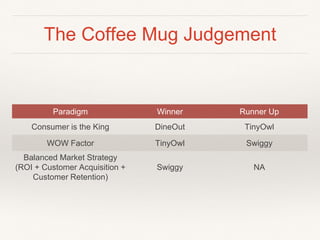Scrum Bangalore 17th Meetup - June 11, 2016 - Coffee Mug Paradigm - Nitish Gulati - at Prowareness
- 1. Lean Product Marketing - Case Study The Coffee Mug Paradigm By, Nitish Gulati, Product Owner, Cybrilla Technologies & Blogger www.nitishgulati.com
- 2. What is the case study? ❖ Sector - Food Tech. ❖ Companies - TinyOwl, DineOut, Swiggy. ❖ Key Factor - Coffee Mug - Start ups going nuts over it! ❖ Focus - Relentless focus on distribution of free coffee mugs to attract customers to stalls.
- 3. Situation Analysis ❖ Model - Offline Marketing through stalls at various locations. ❖ Peak Time to engage with consumers - ❖ 9.30 - 11.30 AM (Breakfast) ❖ 12.30 - 3.00 PM (Lunch) ❖ 5.00 - 6.30 PM (Snacks) ❖ Total time for engagement - 420 mins per day ❖ Locations – Waverock SEZ, Hyderabad
- 4. Testing the Data Waters Brands Dineout Swiggy TinyOwl Factors Staff at the stall 3-5 5-7 3-5 Stall Positions (Single Location) 2 2 1 Number of Days 2 2 1 Cashback Rs 100 NA 100% up to Rs 150 Mugs Handed Out 420 168 NA Stall Decoration Simple Grand Moderate Orders Achieved NA 84 NA Engagement Time 420 mins per day 420 mins per day 300 mins per day A bird’s eye view of the defined metrics
- 5. It’s somewhat measurable, but is it working? ❖ Not really lean! ❖ Where are the Key performance indicators (KPI’s)? ❖ If KPI’s exist, which facets of a coordinated marketing campaign are having a positive impact on them? ❖ Let’s introduce something called- Lean Product Marketing
- 6. Lean Product Marketing - What is it? ❖ Validating learning and being able to judge the needs of early customers. ❖ Identifying the minimum viable product (MVP) and being agile around it with respect to marketing. ❖ Value, experimentation over planning. ❖ Testing and metrics are vital to the growth
- 7. Applying Lean Marketing - Let’s deep dive Brands Dineout Swiggy TinyOwl Business Case Install Enter code Credit of Rs 100 Get mug Install Min order of Rs 50 Get mug *100% cash back up to Rs 150 *Play dart game - 5 chances. Up to Rs 300 back. Get mug Observations *Network Issues *Time to register pre download *Network Issues *Time to place order *Less numbers due to costs involved *Network Issues *Time to play game *Breakfast time not included (Lost 120 mins) Assumptions Approx. 2 mins time for installation, code redemption and registration Approx. 4-5 mins for installation, placing order and collecting mug Approx. 3 mins for playing game, code redemption and registration
- 8. Applying Lean Marketing - Let’s deep dive (cont.) Brands Dineout Swiggy TinyOwl Tangible Factors Staff at stall ₹7500 ₹10000 ₹7500 Rent ₹28000 ₹28000 ₹14000 Cashback ₹42000 NA ₹ 40000 (30 + 10) Mugs ₹21000 ₹8400 ₹5000 Stall decoration ₹5000 ₹10000 ₹5000 Orders Achieved NA ₹8400 NA Total ₹61500 ₹48000 ₹78500 Non tangible factors Stall Attraction Simple Grand Moderate Customer profitabilty Grand Moderate Simple ❖ All values in Indian Rupees (INR)
- 9. ❖ What could the 3 start ups have done differently post this analysis? ❖ Plan for a Sustainable pace. ❖ Removing Impediments (TinyOwl) ❖ Just In Time Reviews (DineOut) Applying Lean Product Marketing ❖ Lean Marketing Factors used - ❖ Experimentation | Customer feedback | Metrics
- 10. The Coffee Mug Judgement Paradigm Winner Runner Up Consumer is the King DineOut TinyOwl WOW Factor TinyOwl Swiggy Balanced Market Strategy (ROI + Customer Acquisition + Customer Retention) Swiggy NA
- 11. Conclusion ❖ Lean product marketing is a cycle – Not a big bang approach. ❖ Have something akin to a MVP ❖ Measurements, like burn down charts, are important ❖ Retrospect helps in maintaining the vision of the brand ❖ Focus on building experience with consumers
Editor's Notes
- Sustainable – plan less do more Remove impediments – adjust along the way JIT - Capture customer feedback in parallel
- Repeat it till one find’s an efficient marketing strategy for the brand












